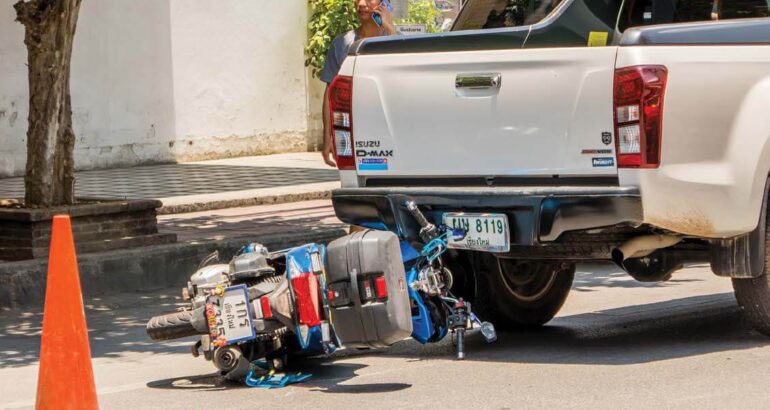A backover incident occurs when a backing vehicle strikes a worker who is standing, walking, or kneeling behind the vehicle. These incidents can be prevented.
According to the Bureau of Labor Statistics, over 70 workers died from backover incidents in 2011. These kinds of incidents can occur in different ways. For example:
▪ On June 18, 2009, an employee was working inside a work zone wearing his reflective safety vest. A dump truck operating in the work zone backed up and struck the employee with the rear passenger side wheels. The employee was killed. The dump truck had an audible back up alarm and operating lights.
▪ On June 9, 2010, an employee was standing on the ground in front of a loading dock facing into the building while a tractor trailer was backing into the same dock. The trailer crushed the employee between the trailer and the dock.
The purpose of this web page is to provide information about the hazards of backovers; solutions that can reduce the risk or frequency of these incidents; articles and resources; and references to existing regulations and letters of interpretation.
How do backover incidents occur?
Backover accidents can happen for a variety of reasons. Drivers may not be able to see a worker in their blind spot. Workers may not hear backup alarms because of other worksite noises or because the alarms are not functioning. A spotter assisting one truck may not see another truck behind him. Workers riding on vehicles may fall off and get backed over. Drivers may assume that the area is clear and not look in the direction of travel. Sometimes, it is unclear why a worker was in the path of a backing vehicle. A combination of factors can also lead to backover incidents.

What can be done to prevent backover incidents?
Many solutions exist to prevent backover incidents. Drivers can use a spotter to help them back up their vehicles. Video cameras with in-vehicle display monitors can give drivers a view of what is behind them. Proximity detection devices, such as radar and sonar, can alert drivers to objects that are behind them. Tag-based systems can inform drivers when other employees are behind the vehicle and can alert employees when they walk near a vehicle equipped to communicate with the tag worn by the employee. On some work sites, employers can create internal traffic control plans, which tell the drivers where to drive and can reduce the need to back up. In some cases, internal traffic control plans can also be used to separate employees on foot from operating equipment.
Training is another tool to prevent backover incidents. Blind spots behind and around vehicles are not immediately obvious to employees on foot. By training employees on where those blind spots are and how to avoid being in them, employers can prevent some backover incidents. One component of this training can include putting employees who will be working around vehicles in the driver’s seat to get a feel for where the blind spots are and what, exactly, the drivers can see. The National Institute for Occupational Safety and Health (NIOSH) has several blind spot diagrams that can help explain what drivers of various large trucks can see.
Backing Safety Solutions
The following list of solutions is not required by any OSHA standard. It is provided for informational purposes only.
Spotter
Spotters are a proven method of protecting employees on foot behind vehicles with an obstructed view, but spotters themselves can be at risk for injury or even death. Employers can implement the following actions to help keep spotters safe:
• Ensure that spotters and drivers agree on hand signals before backing up (see graphics). • Instruct spotters to always maintain visual contact with the driver while the vehicle is backing. • Instruct drivers to stop backing immediately if they lose sight of the spotter. • Not give spotters additional duties while they are acting as spotters. • Instruct spotters not to use personal mobile phones, personal headphones, or other items which could pose a distraction during spotting activities. • Provide spotters with high-visibility clothing, especially during night operations.
Cameras
Most vehicles (and some types of mobile equipment) can accommodate a camera that provides operators with a view to the rear. Some vehicles come equipped with cameras or may be offered with them as optional equipment. Camera systems can also be purchased as after-market equipment for vehicles. Viewing screens may be dash-mounted but must not block the driver’s view out the windshield. Harsh environments, such as some construction sites or mines, may require more rugged cameras. Determining where to mount a camera for maximum effectiveness may be difficult, especially on large vehicles. For example, dump trucks may require two or three cameras to monitor the blind spots on the front, rear, and side of the vehicle.
Proximity Detection Systems
Radar and ultrasonic technology both are used in backing safety systems. A radar system transmits a signal, which is bounced off an object. The signal is then received by a receiver. These systems alert the driver with a visual and/or audio warning. These systems must be positioned so that they won’t detect harmless objects, such as the concrete slab of a driveway, which can interfere with the detection of an object or person behind the vehicle or mobile equipment. Also, the composition of an object can affect detection, with some materials being virtually invisible to radar. Like cameras, this equipment can be mounted on most vehicles and may be an option from some manufacturers.
Ultrasonic systems, such as sonar, emit bursts of ultrasonic waves in a frequency above the hearing threshold of humans. When the waves strike an object, they generate echoes used to determine the distance to the object. These systems alert the driver with a visual and/or audio warning.
Tag-based Systems
Another type of proximity detection system is an electromagnetic field-based system, which is a type of tag-based system. This system consists of electromagnetic field generators and field detecting devices. One electromagnetic field-based system uses electromagnetic field generators installed on a vehicle and electronic sensing devices (a tag) worn by persons working near the vehicle. Another electromagnetic field-based system uses field generators worn by persons working near the vehicle, with the sensing devices installed on the vehicle. These electromagnetic field-based systems can be programmed to warn affected workers, stop the vehicle, or both, when workers get within the predefined danger zone of the vehicle.
Internal Traffic Control Plans
An internal traffic control plan (ITCP) is another method used to address backover hazards. These are plans that project managers can use to coordinate the flow of moving equipment, workers, and vehicles at a worksite to minimize or eliminate vehicles and employees from crossing paths. These plans can significantly reduce, or possibly eliminate, the need for vehicles to back up on a site.
Republished from Marine Construction Magazine Issue V, 2022










